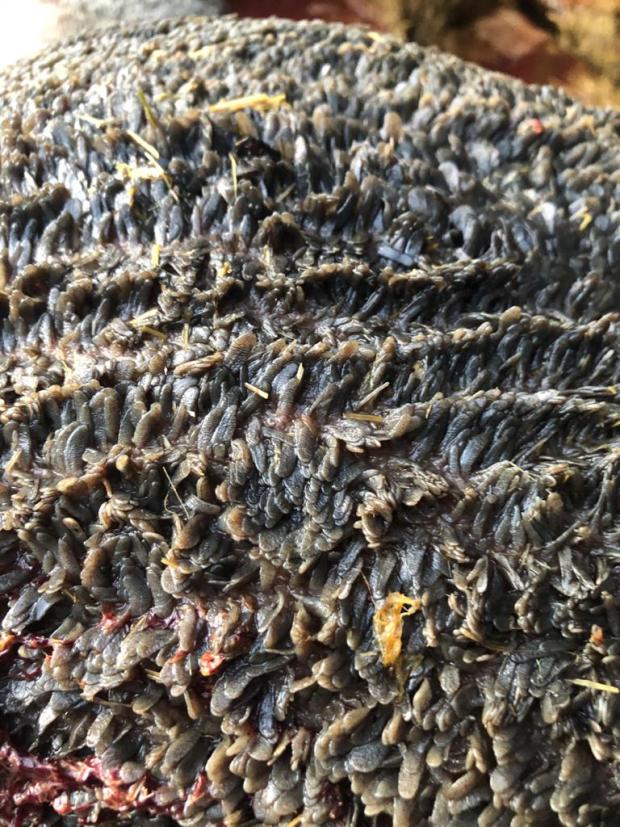
The farmer in question was approached by an agronomy company in 2018 to spread a new supply of liquid fertiliser on his land, but in the weeks and months that followed, several of his cattle began to experience fertility issues, decreasing milk yields, signs of lameness, problems with their rumen function and abortions.
Prior to using this fertiliser, he reported that milk yields were strong, fertility was running at a good level of conception and cows feet were in good condition – with routine foot bathing carried out. The farm was also receiving bonus payments for higher quality milk and cleanliness.
However, in the last three years, chemical analysis carried out on samples of the fertiliser, soil, grass, and silage, had highlighted some concerning findings which have been shared with The Scottish Farmer.
Speaking exclusively and anonymously with The SF, the farmer hoped that his story would send a warning to other farmers to be extra vigilant about what they are spreading on their land and to ask for full clarity on any products they use.
“We were approached by this company to switch from bagged fertiliser to a liquid application which it said would help add sulphur to our grass. After the initial application, the first thing we noticed was weeds began disappearing on the farm, noticeably ragwort and other weeds. Docks, thistles, and nettles all declined over time.
“When we turned the cattle out to graze three weeks later, fertility issues started to emerge, with fewer cows coming into season. We began to notice them becoming more lethargic and experiencing issues with mobility.
“We were producing 8000 litres per cow in the years prior to using the fertiliser, but quickly afterwards we began to witness an increase in our feed intake but a reduction in milk yield – and the gap kept growing.”
He reported that milk yields decreased to 5000 litres per cow and added that the quality was all over the place.
“From the moment we used the fertiliser, mortality rates in our cows and calves increased,” he continued. “We had a low average mortality rate beforehand, but mortality rates almost doubled over night.”
As well as noticing changes with his livestock, he discovered mold was growing at an ‘alarming rate’ in his silage clamp and sent it off for testing. The findings revealed the growth was penicillium roqueforti, which he had explained to him produced the mycotoxin PR-toxin, which can be poisonous to animals.
“The mold grew in days, not weeks or months – 1500 tonnes of silage were binned due to being classed as unfit to be used as animal feed,” he said.
In November, 2019, a cattle specialist was asked to come and see the herd and report any suspicions. “The first thing I noticed was the cow sheds smelt horrendous, like rotten eggs,” he told The SF, citing concerns over possible hydrogen sulphide. “The cows were in pain, there was a lot of groaning and grunting. Content cows make little noise.”
A few days after his first visit to the farm, one of the cows went downhill rapidly and the farm vet was called out to do a post-mortem. “When he cut open the cow’s rumen it was black inside and litmus paper found it to have a pH of 8. The cow was alkaline, no one had ever seen this before but is mostly seen when urea has been used in the diet which had never been done on this farm. Could this be attributed to high urea content in the fertiliser?”

He organised for a chemical analysis to be carried out on soil, grass and silage samples and at the time had expected they would find urea and a couple of other components which could have been put down to a ‘mix gone wrong’ but instead he said their ‘worst fears were confirmed’.
“The analysis revealed traces of petrochemicals, plastic bottle compounds, birth control pills, clothing, paint stripper, pesticides, herbicides, anti-cancer treatments, brake fluid, hair conditioner, plus many more shocking findings.
“It became clear that all sorts of material had been tipped in a lagoon and there was no real documentation of what has been going in. We even found a drug for epilepsy which is only used with kids – this suggested that possible waste from hospitals had been included.”
He also observed that some of the cattle appeared to be exhibiting symptoms typically associated with having a hangover, or a headache and attributed this to signs of addiction witnessed in the herd.
“Everything raised suspicions, from poor fertility to dropping milk yields, from emerging feet problems to digestion issues. Post-mortem reports of some of the cattle found cases of gangrene mastitis, which is extremely rare, as well as traces of salmonella.
“This was a good progressive farm doing well and as soon as they applied this liquid fertiliser, the wheels fell off and everything started to go wrong,” the expert told us.
This type of liquid fertiliser is known for being delivered and spread on the same day, which made it difficult at first to track down any samples to be analysed. In a stroke of luck, the farmer managed to track down one farm where two tanks of fertiliser had been left on-site and samples were taken and analysed and found to match the findings in the soil, grass and silage analysis.
“No one has ever analysed this fertiliser before because it had never been left on farm,” the cattle specialist continued. “There were no data sheets, nothing about what chemicals were included, or any hazards detailed for users. It was being transported without paperwork, which is against the law,” he contended.
“Now fertiliser has rocketed in price from £200 a tonne last year, up to £300 a tonne this spring, farmers will be looking to save on costs and big companies could take advantage of this by cutting corners through means such as this.”
He added that he knew of at least five other farms which had experienced the same problems with their cattle and silage, but that they are not willing to come forward at this stage.
The SF contact SEPA for insight into the rules regarding human waste use in fertiliser and what processes were in place to make sure waste is properly managed. It responded: “The application of sludge on farmland needs to be in accordance with The Sludge (Use in Agriculture) Regulations 1989. We encourage farmers to go further and use the Safe Sludge Matrix (SSM), which provides clear guidance on the minimum acceptable level of treatment for any sewage sludge.
“Using the SSM, conventionally treated sludge is not to be applied to grazing land unless it is deep injected, or ploughed down, and there must be three weeks of no grazing after either application. Enhanced treated sludge, which is free from salmonella and treated to ensure that 99.99% of pathogens have been destroyed, does not require to be deep injected or ploughed, although the three week no-grazing interval still applies.
“Sludge producers are also required to maintain detailed records of applications of all sludge to agricultural land, including accurate information on the location, the amount spread and the date on which it was spread. These records must be submitted to SEPA on an annual basis as a sludge register.
“Before spreading to agricultural land, sludge producers are required to analyse both sludge and soils for nutrients and potentially toxic elements. Sludge must subsequently be re-analysed at least once every six months or after any event which causes a change in the characteristics of the wastewater being treated.”
In October, last year, an environmental specialist reviewed the contaminates found in the samples belonging to the dairy farm in question and deemed the land and milk to be unfit for human and animal consumption.
The farmer opened up about how hard it has been to watch his family-built business fall apart. “It was horrific when we were told we had to cease selling milk, it was what we were born and bred to do. This situation should never have been allowed to happen in the first place.
“We are an industry trying to do our best and big companies are manipulating things behind the scenes and farmers are being left to deal with the consequences.”
Passing on a final word of warning to farmers on choosing fertiliser for their land, he added: “Be vigilant, be aware of what you are being sold, don’t be frightened to ask sales companies for full clarity on what you are being supplied. If someone is offering you a wonder product, it probably isn’t true and report it straight away.”

























